Green Construction: Easily Navigate the Benefits & Trends You Need for 2021
Ask anyone about top trends in green construction these days. You’ll hear the same answer over and over: smart buildings, smart buildings, and smart buildings. Some inventive new design approaches are helping reduce heating and cooling costs. In the process, they’re also lowering the climate impact of commercial buildings and offices.
When we talk about “smart buildings,” we’re usually referring to IoT integration: network-integrated AI assistants, fridges that update your grocery list, and the mechanical caretaking experiments in these high-rises. But being smarter about buildings also means changing how we choose materials and production methods.
Why Does Green Construction Matter?
Climate change awareness is on the rise. Builders and regulators alike are making serious moves to reduce the carbon footprint of commercial and industrial construction. By some estimates, “global energy demand is set to increase by 4.6% in 2021.” Almost 75% of this growth is from industry and buildings. In Canada, office buildings suck up 18% of the country’s electricity, with residential buildings accounting for a further 33%.
Construction guidelines like Net Zero have established a standard for sustainable building practices. Heavy government subsidies are also making it more affordable to meet the higher upfront costs sometimes associated with green construction.
In this guide, we’re looking at big trends for developers and building managers to keep an eye on in 2021. Plus, stick around till the end for a short overview of the (many and various) green construction certifications in Canada.
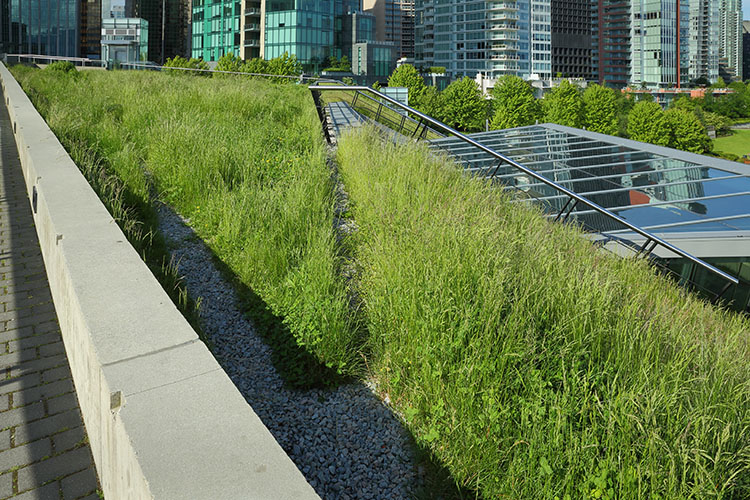
Building for Net Zero Compliance
The Canadian Mortgage and Housing Corporation offers this helpful definition of a Net Zero energy building:
A net-zero energy (NZE) house is designed and built to reduce household energy needs to a minimum and includes on-site renewable energy systems, so that the house may produce as much energy as it consumes on a yearly basis. An NZE home is not necessarily an “energy autonomous” house or “off-grid” house, as it can be connected to the electricity grid, so that it can supply electricity to the grid when it is producing more than it needs and draw from the grid when household demands exceed the amount of electricity produced on site. Taken over the year, the energy supplied to the grid balances the energy drawn from the grid, thus achieving net- zero annual energy consumption.
Reducing household energy use means improving the efficiency of heating, ventilation, and air conditioning (HVAC) systems, reducing heat loss, and cutting down on electricity use. Here are three of the main ways to achieve that.
1. Airtight Building Envelopes
Ever had to work in an uncomfortably drafty office? It might help to know your building manager was probably (almost) equally upset about their utility bills.
Thermal leakage causes heating and cooling costs to skyrocket. Net Zero buildings boast features like triple-pane windows, heavy insulation, and building materials with a high insulation value. Taken together, these measures make it less energy-intensive to maintain a steady, comfortable temperature.
Word to the wise: when improving energy efficiency, remember to take air quality, ventilation, and humidity into account. The Environmental Protection Agency (EPA) stresses that airtight buildings make indoor air quality (IAQ) more important than ever. For example, pollutants like radon and mold can build up faster in airtight spaces.
2. Improving Heating and Ventilation Efficiency
Furnaces and traditional baseboard heating are still a fixture in older buildings. Because they’ve warmed you through many a vicious Western Canadian winter, you may even have some real fondness for them.
But today’s developers are finding ways to reduce our reliance on natural gas and electric. Integrating solar has been one popular trend, and one example is roof-mounted solar panels. They snatch up the sun’s rays and direct their energy into a gravel pit located beneath the building, and the energy powers electric pumps for heating.
3. Smarter Appliances and LED Bulbs
In terms of trends you don’t want to be stuck talking about at a party, “IoT” might be up there with “Bitcoin” and “blockchain.” But in the green construction world, the Internet of Things (IoT) is already very much, well, a thing.
Appliances that automatically regulate their own consumption can significantly curb utility bills. At the same time, high-efficiency LED lighting represents a much greener alternative to wasteful incandescent bulbs. But the biggest IoT-related savings are in HVAC, as we’ll see below.
HVAC Evolves
At Gateway, we’re heating, ventilation, and air conditioning (HVAC) experts, so it makes sense for us to focus a little more on this aspect. In general, heating and cooling uses about 40% of the energy most homes consume. As a result, HVAC impacts how bodies like LEED and Energy Star grade each green building in Canada.
Some examples of automated (IoT) HVAC systems include equipment that monitors:
- Humidity
- Ambient temperature
- How many people are present
- CO (carbon monoxide) and CO2 (carbon dioxide) levels
- The sun’s current position
This creates huge opportunities for so-called green-collar jobs in HVAC. Some technicians are able to marry their traditional skills with an understanding of how to integrate newer technology. As a result, they’re likely to see major benefits from the industry’s new normal.
Higher Demand for Green Construction Materials
Along with the trends we’ve identified above, we expect a surge in demand for the green materials these new approaches rely on. As discussed in our Ultimate R22 Replacement Guide, there are significant shifts in the supply and demand of key materials. This will have a ripple effect for industry buyers, as well as the Canadian manufacturing industry.
We can expect demand for window products, insulation, heat recovery ventilators (HRVs)—and heating, ventilation, and air conditioning (HVAC) equipment to surge in the future. According to the Vancouver Economic Commission, this decade could see demand for these rise to over CAD $3.3B annually—in Metro Vancouver alone.
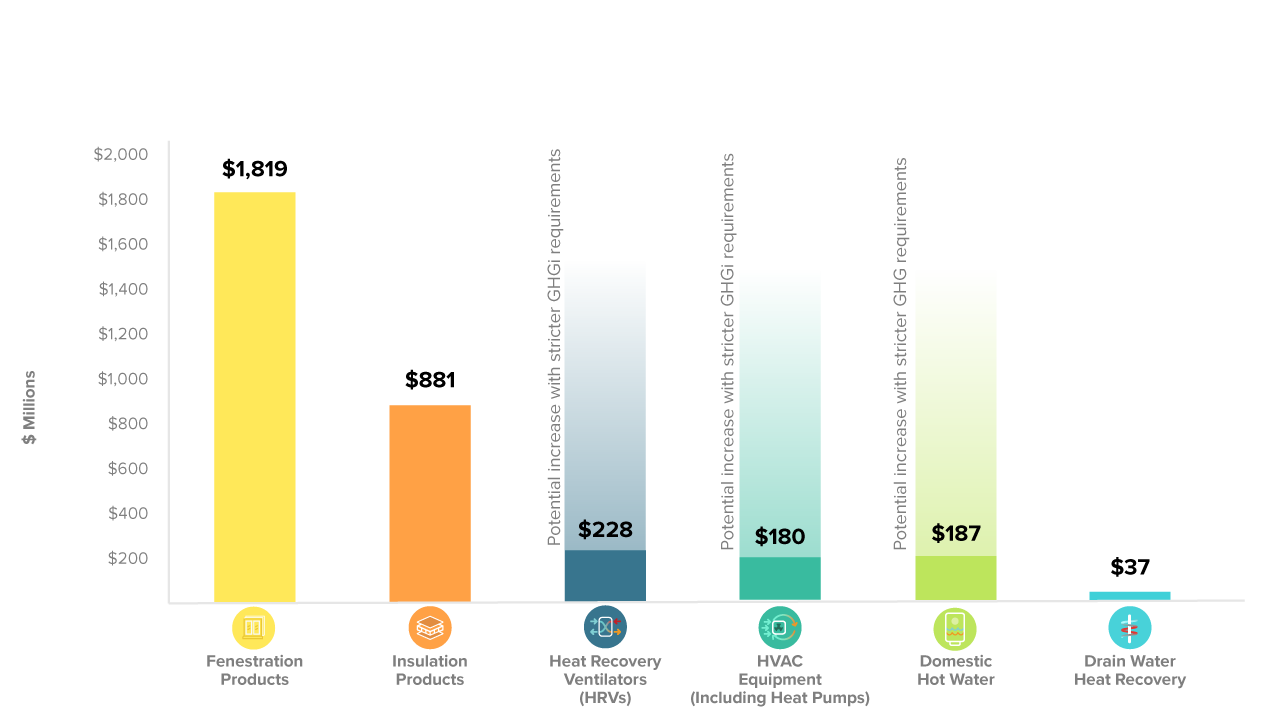
The same report claims the market for low-performance products (particularly windows) may plummet after 2022. What does this mean for builders? Well, start phasing out low-efficiency products and ensure you have a solid network of suppliers for high-efficiency replacements. You can also use recycled materials and upcycle existing items to show off your dedication to green construction.
As for buyers, don’t let the slimmer sticker price of low-efficiency materials fool you.
After all, “fire-sale prices” should always make you question what caused the fire in the first place!
Retrofit Mania
Earlier in this piece, we mentioned how large buildings are a big share of Canada’s greenhouse gas emissions. And while greener construction on new structures will mitigate this over time, those existing polluters aren’t going anywhere soon. In fact, at least half of them will still be operational in 2050, according to the Canada Green Building Council. That means we need to take action to reduce the carbon footprint of large buildings.
The report recommends combining deep retrofits, on-site renewables installation (like solar panels or wind turbines), fuel-switching, and recommissioning. We’re already seeing local government subsidies and rebates to support this work. Building owners have been taking advantage. This has prompted a spike in green retrofit work that’s set to gain momentum in the years to come.
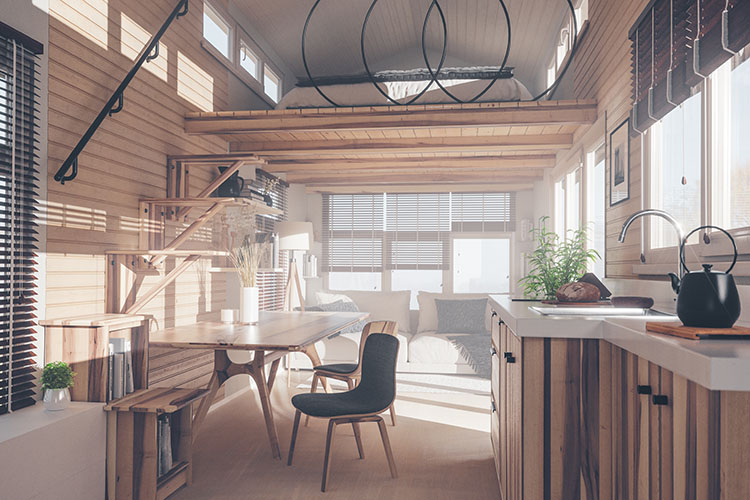
Modular Building’s Moving On In
Modular construction, or the practice of building a structure in sections at an off-site location and then transporting them to their final destination for assembly, is becoming increasingly popular.
This is partly due to its higher efficiency and reduction of waste materials. In 2021, construction materials are in short supply and high demand as we navigate the always-changing COVID-19 economy. Even so, modular buildings still tend to cost less to build. Social distancing could play a role in greater modular demand, too. That’s because workers assemble modular sections in large spaces where everyone can stay at least six feet apart.
Homes built with these methods could have 40% lower greenhouse gas emissions than those constructed on-site. Depending on the facility, some factories can ensure a tighter building envelope and use less energy themselves in the process. Factories tend to have much better recycling programs than traditional construction sites. It’s also more efficient to increase production of prefabricated elements using robotics than to rely on human manual labor.
Indoor Air Quality
Did you know indoor air pollution causes up to 50% of respiratory illnesses? And we were already spending up to 90% of our time indoors—before the pandemic?
And viruses like COVID-19 can spread through your building’s HVAC system?
Those are scary facts.
And they’re why many companies—including your friends here at Gateway—are focusing on indoor air quality in 2021. Everyone cares more about making sure their air is healthy while they’re staying inside. Hopefully this is one trend we can all follow long after 2021 is over.
(Not sure if your building’s indoor air quality is up to par? Try our indoor air quality assessment!)
Green Construction Certifications in Canada
There are quite a few green construction certifications out there. The government administers some, while industry associations and NGOs oversee others. Here are the big ones.
1. Energy Star
The best known is probably Energy Star—or ENERGY STAR, as Natural Resources Canada prefers to stylize it (NRC). The logo seems to be everywhere you look. However, we find that people outside of the construction industry rarely know what it means in practice.

Energy Star recognizes structures designed to use less energy, emit lower amounts of greenhouse gasses, and cost less to operate. Natural Resources Canada (NRC) evaluates buildings and scores them on a 100-point scale. Those above 75 are eligible for Energy Star recognition.
If you’re interested in applying for this certification, NRC offers a handy web portal.
Heads up, though! Energy Star is only available for “K–12 schools, commercial offices, hospitals, supermarkets and food stores, medical offices, senior care communities and residential care facilities, and ice/curling rinks,” per the NRC’s site.
2. BOMA BEST
The BOMA BEST Awards (the Building Owners and Managers Association’s Building Environmental STandards) also gets our award for the biggest mouthful of a name. As you might’ve guessed, BOMA BEST is an industry standard for commercial building sustainability.

BOMA BEST is also the only Canadian certification program of its kind for commercial buildings. It has significant uptake: more than 7,000 buildings have earned its seal since 2005.
3. LEED
We know Energy Star provides governmental certification, and BOMA BEST supplies industry oversight. LEED (Leadership in Energy and Environmental Design) provides a welcome, internationally recognized third-party alternative.

In Canada, LEED is administered in partnership with the Canada Green Building Council (GBC Canada). LEED’s results have been impressive, at least in terms of sheer numbers, as this quick explainer video shows.
4. WELL
Green construction certification is already a big deal, but the WELL Building Standard goes a step further. Designed by the International WELL Building Institute (IWBI), WELL is a framework to make buildings healthier and protect everyone inside.
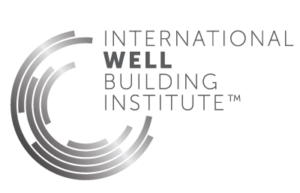
WELL certification focuses on mental and physical health with 10 core concepts. It’s also backed by third-party verification through IWBI’s team-up with Green Business Certification Inc. (GBCI).
Think your space is too small for WELL to matter? Think again. WELL Building Standard can scale to fit your facilities and your business’s needs. That sounds like the perfect way to “make everyone, everywhere, healthier, happier and more productive.”
5. Green Key
Our last example is a more niche industry certification program. Hotels and hospitality organizations have the option of applying for recognition by the global Green Key Eco-Rating Program.
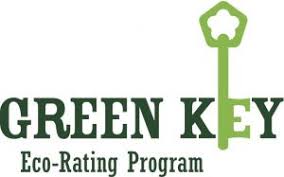
After a thorough environmental audit, the program awards each business with a “green key rating” on a five-point scale. The rating is based on factors like their buildings’ energy efficiency, solid and water waste management procedures, and housekeeping approach. (For example, think changing the sheets every day versus every other day.)
Green Key then provides the hotelier with recommendations to help them “unlock” a greener operating policy. They’re really committed to the whole “key” metaphor.
Wrap-Up
Well, that’s it for our look at green construction in Canada this year.
We hope it’s helped you get a sense of the where the industry is headed in 2021 and beyond. As always, don’t hesitate to contact us if anything you read prompted questions about your own heating, ventilation, and air conditioning (HVAC) systems—and what opportunities are out there for you to get greener!
We love to hear from you! If you have any comments, suggestions, or questions, please feel free to post them below.
This article was originally published in June 2019. We’ve since updated it to reflect recent developments.


